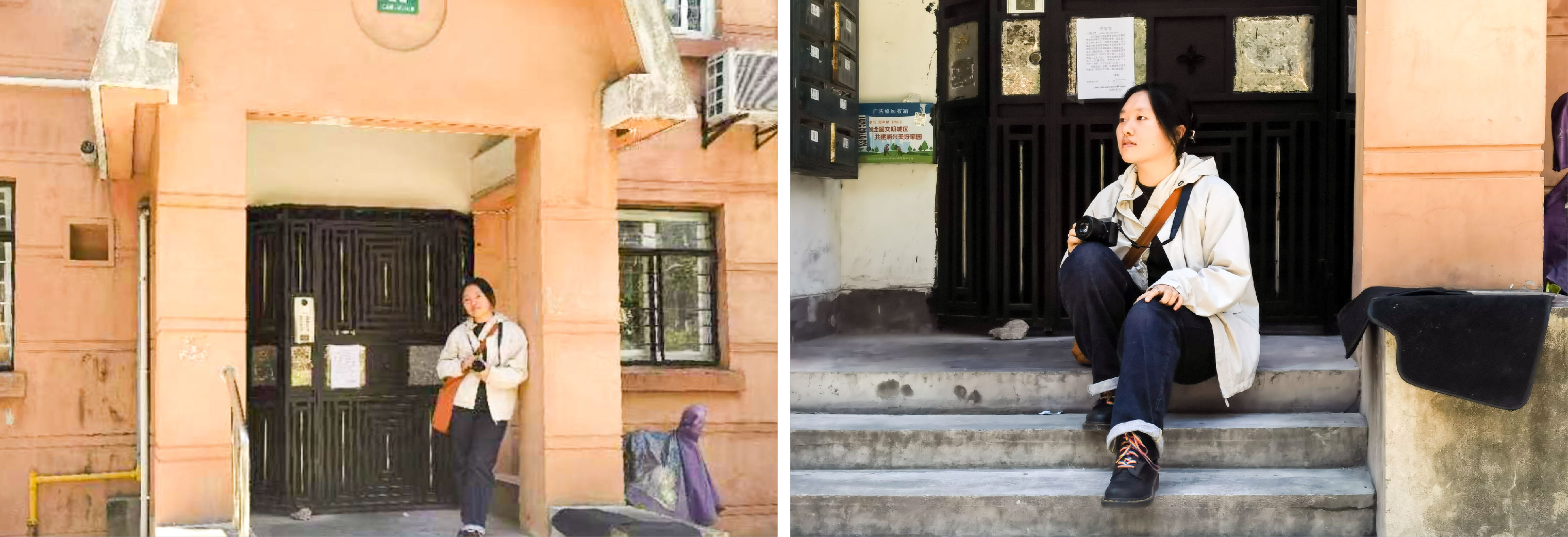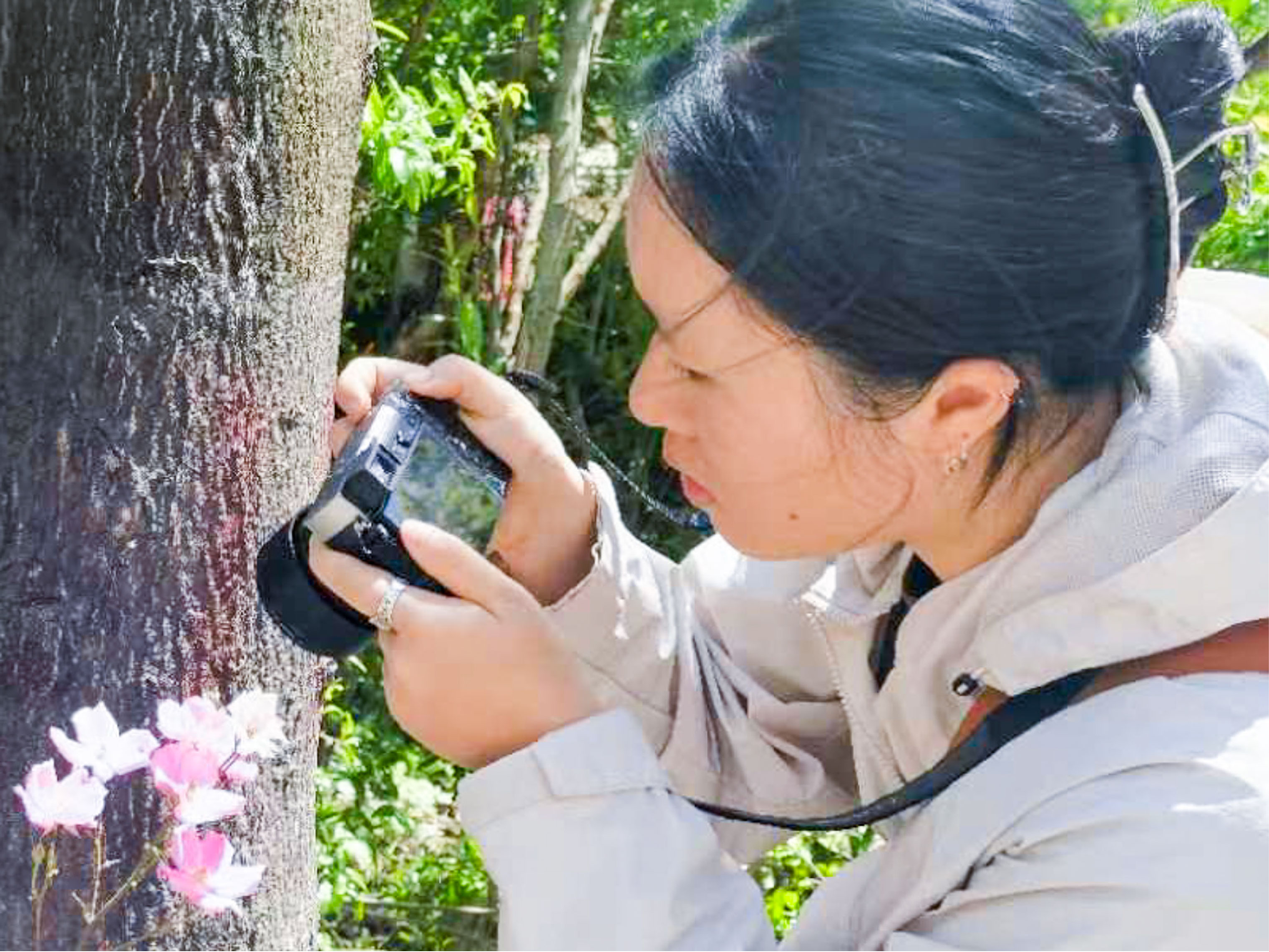
Ever since Aria Zhang ’24 was a kid, she’s had an affinity for the natural world, and all the creatures, great and small, that thrive within it. Growing up in the Jinqiao neighborhood of Shanghai, Zhang remembers exploring the outdoors with her parents and watching BBC nature documentaries together. She said these early childhood memories paved the way for her career goals and aspirations.

Aria Zhang visiting her childhood home in the Jinqiao neighborhood of Shanghai, where she has fond memories of watching lanternflies as a child.
“I thought it would be cool if I could recognize all the plants I saw,” she remembered, recalling her childhood dream to become a botanist. “But now my goal is to become more of a naturalist who studies all of the natural world.”
When she entered university, she was excited to dive into the world of ecology. One species in particular bridged her education at NYU Shanghai and NYU New York– Lycorma delicatula, or spotted lanternflies as they’re commonly known.

The "blue morph" variety of the spotted lanternfly is distinguishable by the vivid blue color on its wings.
The distinctive bugs and their brightly patterned wings first made an impression on her during her early childhood nature walks with her family in Shanghai. She remembers seeing them everywhere. “People stepped on them, cars ran over them, and the red color squashed on the pavement was a bit disgusting for me to see,” she recalled.
When she traveled to the US to study away at NYU’s New York campus in Fall 2022, she was surprised to see some familiar faces– the bugs she remembered from her childhood in Shanghai were there too. “I was just super impressed the lanternflies had made it all the way to New York City,” she said.
The spotted lanternfly is native to the forested areas in Shanghai, but in the US, they are considered an invasive species and are a common sight amidst the skyscrapers and heavy street traffic of New York City. They are thought to have been first brought over to the US on shipping containers, where they thrive without natural predators. Their success in the US, though, comes at a great cost to the environment. Spotted lanternflies negatively impact their habitats, including trees, plants, and other insects.

Aria Zhang (far left), Professor Winchell (in purple), and her lab classmates pose for a picture on the day of her last lab meeting before leaving New York City.
Working with Assistant Professor of Biology at NYU New York Kristin Winchell, Zhang began independent research which would span two continents, focusing on spotted lanternflies in New York and Shanghai. Zhang grabbed her field gear and got to work studying the thermo-tolerance of the insects, or their ability to survive extreme temperatures. “It can help us understand the spotted lanternfly as both an invasive species and a species that is adapting to urban environments in both their native and invasive ranges,” she explained.
Zhang studied the lanternflies during her junior and senior years, learning mapping software and developing skills like data visualization and analysis tools under Winchell’s guidance. “She acknowledges even my smallest accomplishments,” Zhang said of her mentor. “She taught me to do coding and GIS analysis step by step from the very basics.”
Back in Shanghai, Zhang went out to the forests to collect live specimens, but she found they were more difficult to find than on the streets of New York. “My dad would drive me all around Shanghai looking for suitable sampling sites until we found a sufficient amount of bugs that were easily accessible,” she said. Finding the bugs was only part of the challenge. Turns out, spotted lanternflies congregate at the tops of trees, out of reach.
Another problem was that the bugs couldn’t survive even a day in the lab. Zhang ended up having to collect specimens in the morning and race back to campus to run her experiments, oftentimes, sacrificing three days a week in the field. Despite the intensity and the time commitment, Zhang said it was worth it.

Aria Zhang conducting field research on spotted lanternflies in a local Shanghai neighborhood.
Zhang’s research found that spotted lanternflies in New York City appear to have a higher tolerance of extreme temperatures than their Shanghai cousins. She suspects the Shanghai urban spotted lanternfly population is not as good at surviving cold temperatures compared to the forest ones because of a phenomenon called “heat island effect,” when an urban environment is hotter due to human activity such as greenhouse gas emissions. The New York City spotted lanternflies are better at surviving extreme temperatures, maybe because of gene expression differences, Zhang added.
Zhang said her research highlights the adaptations the species has undergone as it migrated to the US. “The species has undergone several rounds of evolution from when they first adapted to urbanization in their local range, Shanghai, and then to their invasive range, in New York City,” she said.
Aria Zhang conducting experiments on the thermotolerance of spotted lanternflies in NYU Shanghai's laboratory.
Winchell said Zhang’s research can play a significant role in understanding how lanternflies have adapted to different environments both in the past and the present, adding that her work “helped establish what I hope will be a fruitful long-term collaboration across the NYU campuses.”
“Aria has demonstrated an exceptional maturity, intellectual ability, and work ethic. We would not have been able to collect this data without her,” she said.
Zhang used software to map out different locations of spotted lanternfly sampling sites and analyzed different natural variables to visually represent how temperatures and habitat can impact lanternfly populations. Her research earned her accolades at NYU Shanghai, where she was honored with an award for Best Presentation at the Fall 2023 Undergraduate Research Symposium for her work, “Thermal Tolerance Adaptations of Spotted Lanternflies (SLFs) in New York City and Shanghai.”
While Zhang’s findings could lead to future research into lanternflies in their natural and invasive habitats, she herself is ready to move on. “I’m excited to explore and study more organisms beyond lanternflies,” she admitted.
The brown, or pale morph variety of the spotted lanternfly is distinguished by its beige coloring.
Last month, Zhang walked the stage at NYU Shanghai, graduating cum laude with an honors biology degree, while decked out in a cap adorned with felted wool birds she made herself. In the fall, Zhang will go on to pursue her graduate study in ecology and evolution. But for now, Zhang will likely be found this summer relaxing and unwinding out in nature, perhaps in the company of a familiar spotted lanternfly. “I feel connected to the lanternflies now,” she said. “I feel like they are my bugs.”

